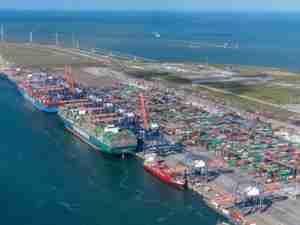The Alabama Port Authority board of directors approved this week a $2.042 million purchase of 272 acres in Montgomery, Ala., to construct an inland container intermodal transfer (ICTF) facility. The project will extend intermodal rail service from the Port Authority’s container intermodal terminal at the Port of Mobile in support of Alabama regional growth in manufacturing, retail, distribution, and agribusiness sectors.
“This project will provide our shippers cost-competitive transportation services to and from one of the nation’s fastest growth containerized cargo gateways,” said John C. Driscoll, director and chief executive officer for the Alabama Port Authority.
When constructed, the intermodal container transfer facility at Montgomery will be serviced by CSX Transportation (CSXT) Intermodal. The project reestablishes regularly scheduled CSXT Intermodal rail service at the Port of Mobile and provides a foundation to expand intermodal services further inland to support CSXT customers. CSXT will contribute up to $12.5 million toward infrastructure improvements in the facility. “This is another great example of how successful partnerships can help foster creative solutions for CSX customers,” said Tom Tisa, head of business development for CSX. “These infrastructure investments will provide the opportunity to grow our business in the region.”
Phase I of the facility is estimated at $54 million and could take up to two years to construct. The project connects inland Alabama shippers to the seaport’s intermodal container transfer facility at Mobile, which is located adjacent to the marine terminal and is accessible to five national Class 1 railroads.
The Montgomery ICTF extends the container intermodal assets at the seaport to public and private investments inside Alabama. One such investment is the shovel ready South Alabama Mega Site where CSX is currently investing $6 million into rail spur infrastructure to accommodate large scale, advance manufacturers. At Montgomery, economic development officials recently announced Amazon’s 650,000 square foot inbound cross dock distribution center and Hyundai Motor Manufacturing Alabama’s (HMMA) recently completed expansion to support the addition of its fourth and fifth models, the Tucson and Santa Cruz. The project is aimed at serving these new investments as well as other regional shippers.
“Alabama’s economy is rebounding stronger than ever, and our Port is doing record business, so, I am thrilled to see us working to connect areas like Montgomery with our gateway to the world,” said Governor Kay Ivey. “Truly, Alabama’s economy will be running on all cylinders with the addition of this CSX Transportation Intermodal. I look forward to the continued growth that is sure to follow.”
The project when completed will generate 2,618 direct and indirect jobs, $340 million in business revenues and over $14.2 million in state and local taxes.
First conceived in its 2001 Master Plan, the Alabama Port Authority’s container intermodal assets comprise of three interconnected and interrelated elements: a marine container terminal, an intermodal container transfer facility (ICTF) and a logistics park utilizing parcels of adjacent land. Phase I operations at the marine terminal began in late 2008, posting consistent year over year growth and completing three expansions adding super post-Panamax capability, capacity and innovation programs geared to efficient customer service. The intermodal rail facility opened in 2016 with intermodal service into Memphis, Chicago, and Canada. The Port Authority is also opening proposals today to negotiate a lease development arrangement at its logistics park. In calendar year 2021, the marine terminal posted 21% growth and the container intermodal rail facility posted 136% growth over the previous year.
The Alabama State Port Authority oversees the deep-water public port facilities at the Port of Mobile. The Port Authority’s container, general cargo and bulk facilities have immediate access to two interstate systems, five Class 1 railroads, nearly 15,000 miles of inland waterways and air cargo connections.










